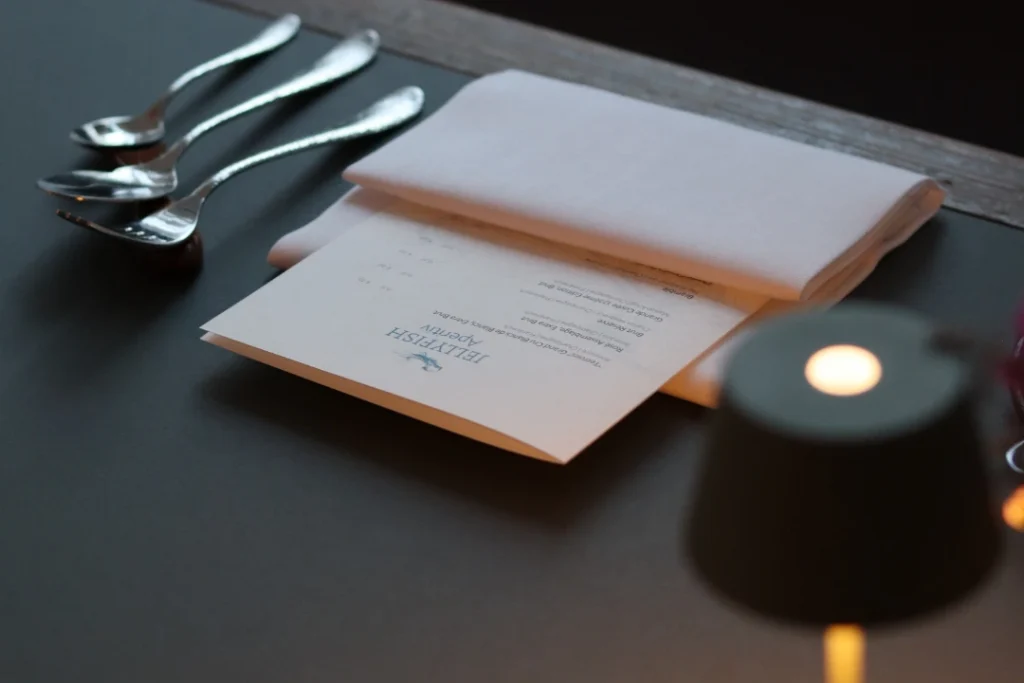Restaurant Jellyfish in Hamburg stands on Weidenallee with a clarity that asks for no explanation.
A simple sign, softly lit. Windows that reveal just enough. It doesn’t hide, but it doesn’t seek attention either.
Inside, the tone is set by proportion.
Warm wood, calm light, well-spaced tables. A bar that anchors the room without centering it. There is no open kitchen, no theatrical arrangement. Only a space designed to hold focus.
It feels like the kind of restaurant that has nothing to prove.
Not because it lacks ambition—but because it knows where to place it.
The welcome is quiet, the pacing unhurried. Not slow, just sure.
Some places impress by arrival.
Restaurant Jellyfish in Hamburg begins with presence.
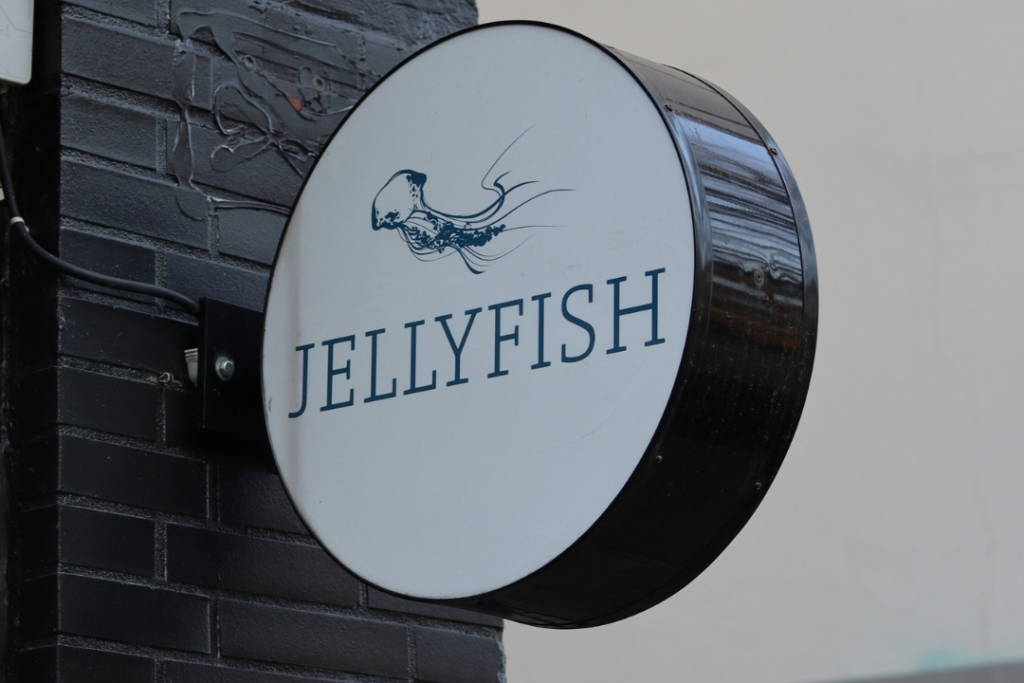
A table near the bar
The evening at Restaurant Jellyfish in Hamburg began with a table near the bar—slightly withdrawn, yet still in quiet conversation with the room. It was the kind of spot that lets you observe without feeling watched. Light fell softly across the surface. A still frame, ready to unfold.
The aperos arrived in sequence, each one distinct in tone.
A tofu tartelette, crisp and cool, layered with pickled radish and citrus apple. A Zander Weißwurst, warm and familiar, softened by a sweet mustard espuma. A kimchi macaron—light, sharp, restrained. And a small composition of Eiersalat, reinterpreted into a single, sculptural bite.
Each plate was explained with precision—calmly, briefly, without excess. The team didn’t perform the dishes. They placed them. They knew when to speak, and when to let the guest continue looking.
The rhythm of the restaurant was careful, but never stiff.
Restaurant Jellyfish in Hamburg doesn’t choreograph an experience—it simply creates space for one.
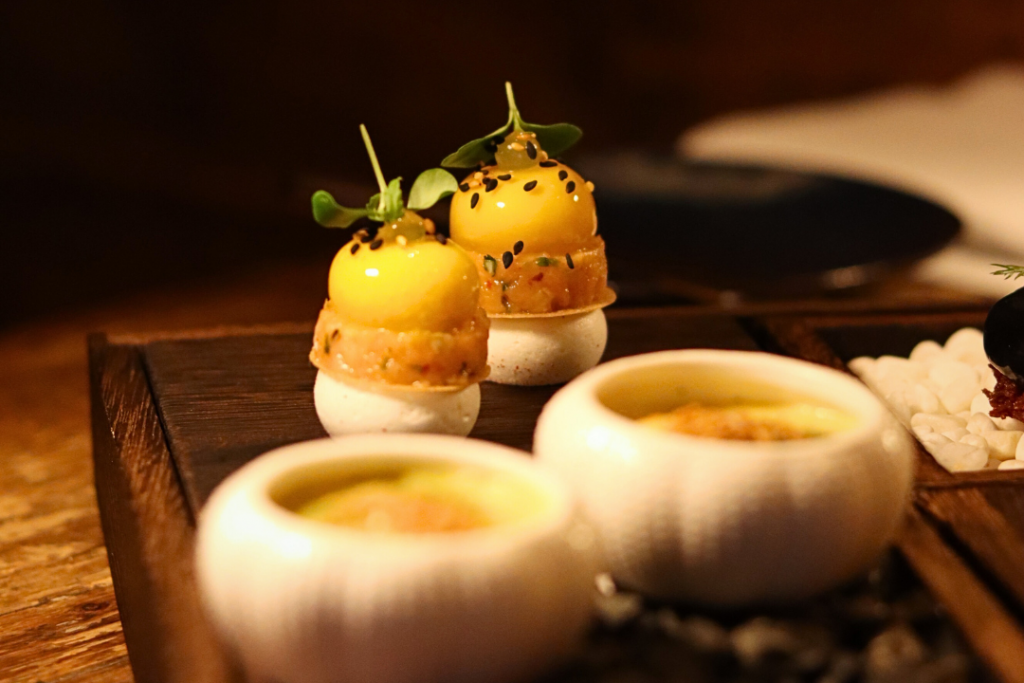
Bread, butter & a quiet warmth
After the aperos, there was a pause. Not in service—never that—but in rhythm. A moment for the table to breathe, to settle into the evening’s tone. Then came the bread.
Two kinds: a dark-crumbed sourdough with quiet density, and a slice of focaccia with a fine parmesan crust that cracked gently under the knife.
Alongside: a soft roll of yoghurt butter, infused with chili and rosemary oil. Nothing was showy. But everything had its place.
A dip followed, warm and deep—onion soup transformed. The flavours of leek, beef stock, aged mountain cheese and garlic held together by cream. A kind of memory in a bowl, reimagined with restraint.
Then, the amuse.
A small plate, delicately layered: beetroot, potato, Wels fish shaped into a Königsberger Klops, crowned with caper espuma and fried caper blossoms. There was nothing nostalgic here—just a quiet reworking of what was once familiar.
This wasn’t a beginning. It was a grounding.
A way of saying: from here on, we continue with intention.
Unfolding menu
The shift from amuse to menu felt almost imperceptible.
No break, no staging. Just a new plate, a new texture, a continuation in another register.
It began with a dish that looked like a root—but wasn’t.
Parsley Root reworked as sculpture: mousse, mole, Brunoise, coffee, anise, citrus. Warm earth and quiet acidity, bound by structure rather than contrast. Not dessert-like, not savoury in the usual sense. Just… composed. Unexpectedly clear.
Next came a composition called “Sülze”, though it bore little resemblance to what that name might suggest.
Shellfish—mussels, shrimp, calamaretti—layered in a translucent aspic of saffron and parsley. Served alongside: a glass with tomato-dressed bread salad, and a small tart filled like a miniature market. It was a dish of memory and movement, cooled by yogurt-feta espuma, drawn together by olive oil and citrus.
Then, the foie gras.
Or rather: what foie gras could be, when it chooses not to be forced. Unstuffed. Layered like a slice of cake, covered in yogurt gel and sweet wine jelly, dotted with currants and herbs. Brioche on the side. Apricot, macadamia, a sliver of brick pastry. No need to argue tradition—just rewrite it quietly.
Finally, Bonito.
Sliced, seared, resting between grapefruit, sweet potato and grilled avocado. Tigermilk air, soft heat, cold cream, crackling maize. A ceviche, yes—but more a sketch of the Pacific through a northern eye. Nothing shouted. Every flavour had space.
Four plates. No hierarchy. No crescendo.
Just movement—clean, considered, complete in its own way.
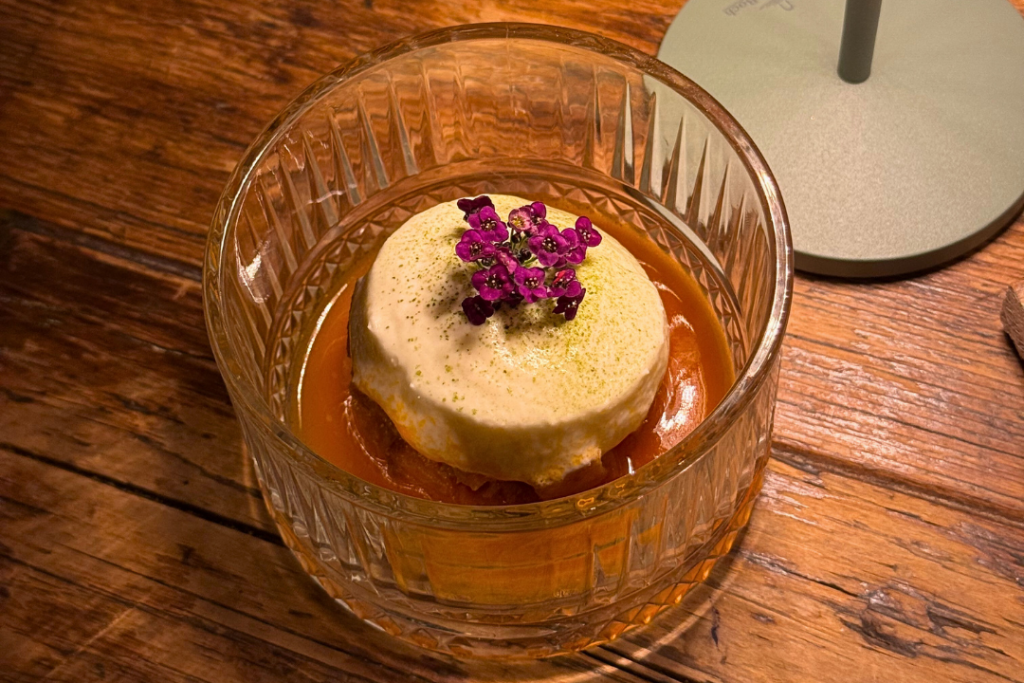
Land and afterwards
The shift from sea to land came without contrast.
It wasn’t a pivot, but a continuation. A slow deepening of tone.
First, the Spessart trout—grilled on the skin, brushed with plum, resting on red cabbage and smoked onion. A dish shaped by warmth and shadow, yet anchored in clarity. Each element in dialogue, nothing overstated.
Then: Scottish salmon, gently cured and cooked in aromatic butter. It arrived with pistachio, horseradish, and cauliflower—roasted, creamed, crisped. The composition felt exact, not decorative. A geometry of textures, bound by quiet rhythm.
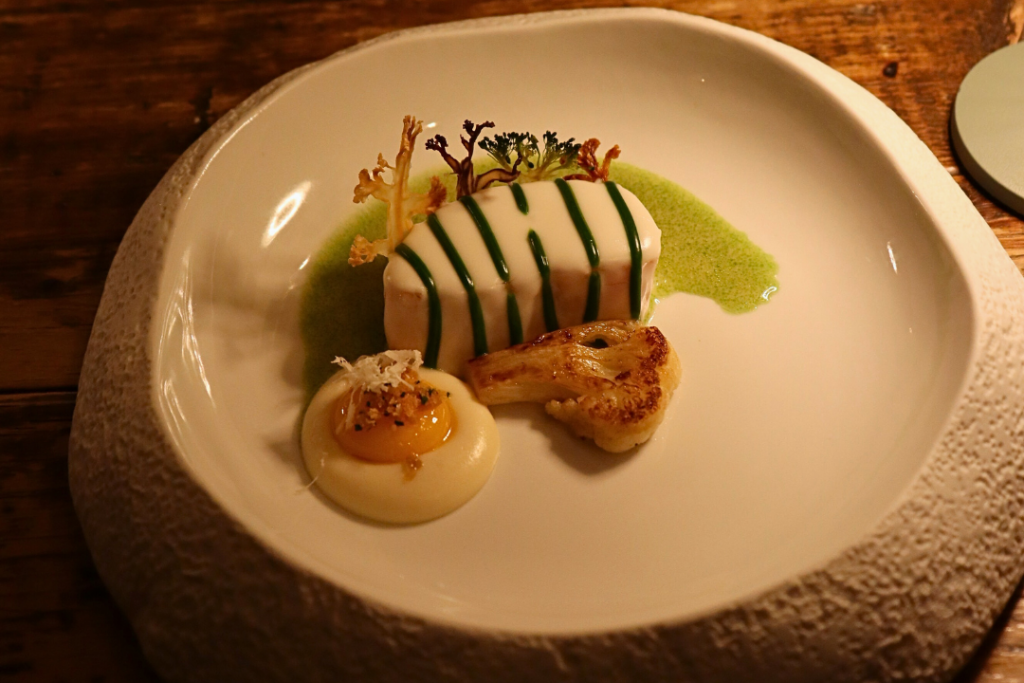
The butcher’s plate brought weight, not volume.
Organic pork—braised, cured, seared—presented with sauerkraut foam, smoked savoy cabbage, and fine cuts of apple and mustard. A dish of patience. Nothing rushed, nothing out of place. Thought turned into temperature.
A small bridge followed: Picandou goat cheese and pear, shaped like a cake, finished with caramelised walnuts and a single spoon of caviar. Not a pause, not yet dessert—just a shift in register.
And then: the mango.
Reconstructed, reframed. A shell of cocoa butter, filled with coconut, rice, banana, lime. A green tea broth. Thai herbs. Mai Tai sorbet. The flavours were clear, but soft. A final plate that felt less like an ending than a quiet echo.

The closing moment
By the time the petit fours arrived, the room had settled into a slower rhythm.
Not quiet, but softened. The kind of stillness that comes when there is nothing more to expect, only to remain.
A small tiramisu, layered and cool. A mandarin praline, a truffle touched with whisky and blossom. A chocolate ‘mushroom’ made of tonka and white truffle. A sorbet lollipop, crisp and cold. A final note of mojito, reduced into fruit.
Each was placed without announcement.
No gesture to suggest a finale—only continuity. A last series of textures, as thoughtful as the first.
There was no need to speak.
The evening at Jellyfish Hamburg had already said enough.
Why it matters
Some restaurants tell their story through noise.
Jellyfish in Hamburg does so through balance. Through choices that feel deliberate, but never forced. Through a sense of rhythm that holds the room, rather than moving it forward.
There is no manifesto. No headline dish.
Just a quiet understanding of how things can come together—plate by plate, thought by thought, detail by detail. What arrives at the table isn’t just food. It’s attention, materialised.
Jellyfish in Hamburg doesn’t only perform. It listens. And what remains, long after the meal, is not a single moment—but the way all the moments belong to each other.

